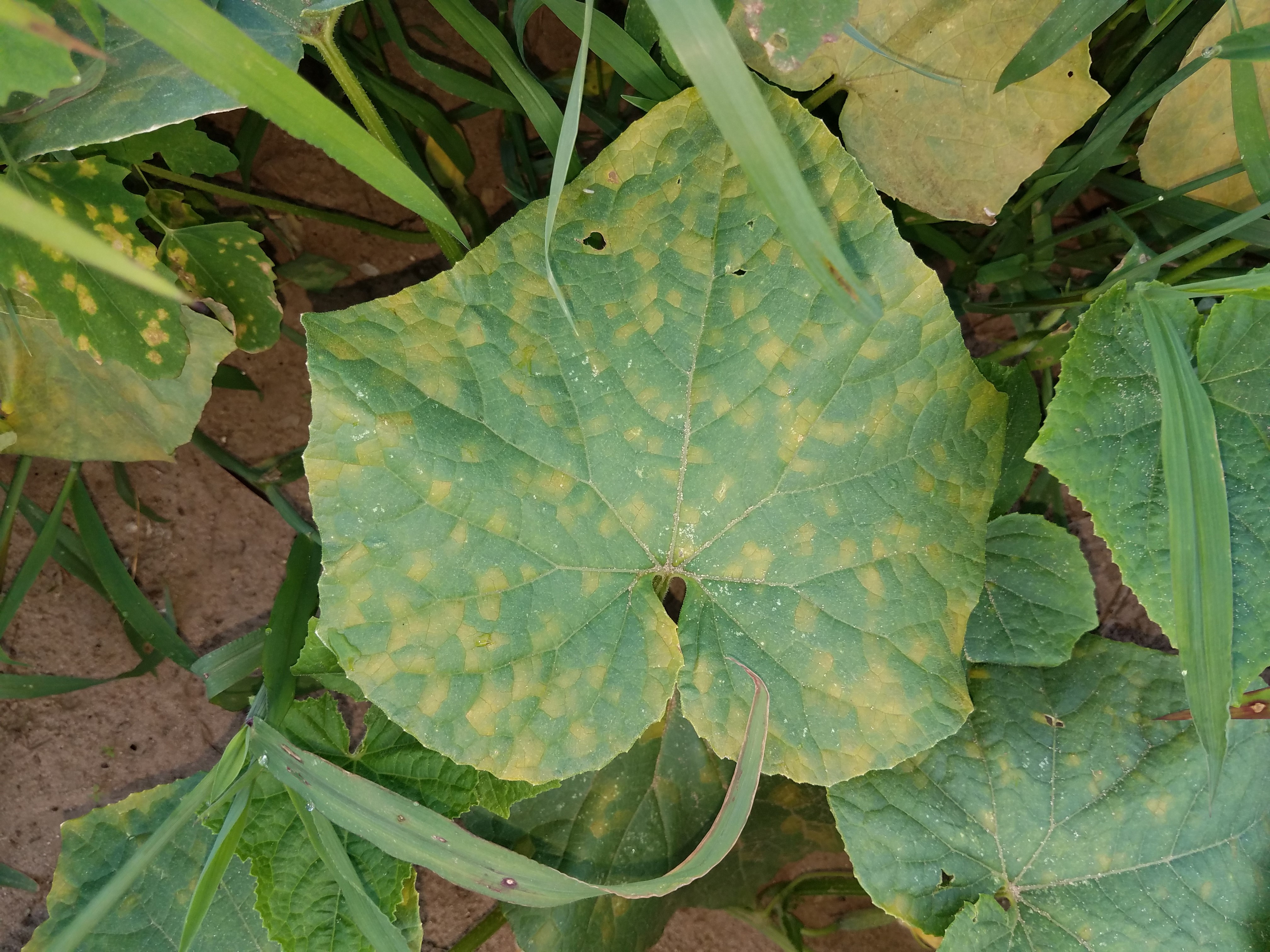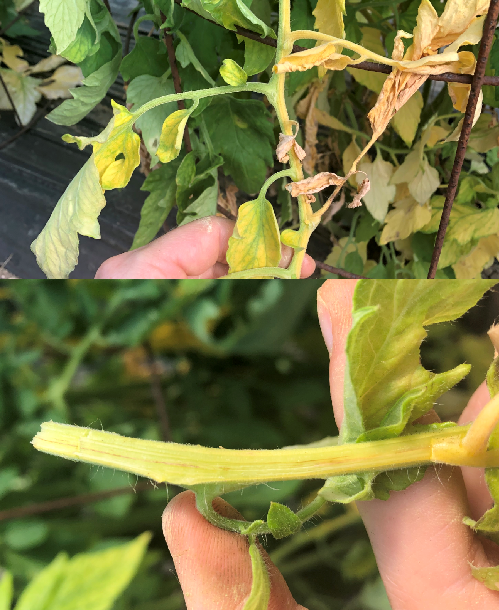Southeast Michigan vegetable update – July 31, 2019
In an unusual year like this, arm yourself with information. Scouting is more important than ever as insect activity picks up and dewy mornings promote disease.

Weather
Rain over the last week brought some much-needed moisture, though the amount of precipitation was highly variable. The rest of the week is forecasted to be dry and mild.
The table below shows rainfall totals for the stations in southeast Michigan, as well as degree-days calculated using the Baskerville-Emin Method. Averages for Commerce and Hudson are over five years, while Deerfield is over three years. Rainfall is in inches, with information in parenthesis indicating the change since last week. For a refresher on degree-days and how to get this information in your area, see “Accessing growing degree days with Enviro-weather” from Michigan State University Extension.
|
Rainfall and degree day totals as of July 31 |
||||
|---|---|---|---|---|
|
Station |
Degree days (base 42) |
Degree days (base 50) |
5-year degree day average (base 50) |
Rainfall since April 1 |
|
Commerce |
2,294 |
1,483 |
1,546.1 |
15.22 (+0.97) |
|
Deerfield |
2,519 |
1,660 |
1,845.1 |
16.35 (+0.24) |
|
Hudson |
2,374 |
1,554 |
1,652.7 |
14.26 (+0.13) |
Crop reports
In cole crops, cabbage loopers and aphids have seen an uptick in numbers, especially on organic farms. As cole crops are harvested, work to incorporate residue in a timely manner. This gives the residue more time to break down, which can help manage diseases like alternaria and black rot in future years. Insect pests like cabbage maggot and swede midge have multiple generations per year and can use already harvested fields to complete their life cycles and increase their number for future generations and years.
For cucumbers, cantaloupes and watermelons, downy mildew has been confirmed on cucumbers in Berrien County in southwest Michigan. This location is conducive for spore movement across the state. The weather has been favorable for spore movement and infection—we’ve had fog, long dew periods, high humidity and overcast skies. I have not seen downy in our area; environmental stress and angular leaf spot are what I have seen.

Downy mildew is easiest to spot in the morning while leaves are still dew covered. The upper side of the leaf will have blocky yellow areas, and the underside will have water-soaked or dusty gray areas. Everything will be contained by the leaf veins, which can give it an angular or pixelated appearance. If you suspect you have downy mildew, call me at 517-263-5309 and I can come out and take a look.
Peppers are being harvested. Blossom end rot and sunscald are common. Remove affected fruits so the plant focuses its energy on the peppers you can sell. The heat wave two weeks ago caused some plantings to lose flowers, and they are now missing a round of fruit set.
For potatoes and tomatoes, late blight was confirmed in Erie, Pennsylvania, just down Lake Erie from us. Be vigilant in scouting, as the humidity and dewy mornings are conducive to infection and spread.
In pumpkins and winter squash, note that in fields with a history of phytophthora, sprays can help protect young fruit before their skin hardens. How well this works is dependent on crop and your ability to get products onto the developing fruit. In research trials, the active ingredients most effective in reducing fruit rots were mefenoxam and oxathiapiprolin. Mandipropamid (Revus) and fluopicolide (Presidio) can be alternated in as B-team products. For full details, see the MSU Extension resources “Phytophthora crown rot on cucurbits and peppers requires an aggressive approach” and “Managing Phytophthora on Winter Squash and Pumpkin.”
Sweet corn harvest is ongoing. I’m getting reports from growers of all sizes and management strategies about wormy corn. The culprit is likely corn earworm (see above picture), which is typically more of a pest in August, but is causing issues early this year for two big reasons, which I explain in detail in my accompanying article, "Managing corn earworm in an unusual year."
In the last week, I caught an average of 9.5 corn earworm moths per night in Monroe County and six per night in Lenawee County. This suggests a four- to five-day spray interval is appropriate, with a slightly longer interval if you have field corn silking in your area. The current high pressure weather system sitting over Michigan is not conducive to more corn earworm being dumped in our region, but this could change as the next weather system moves in.
We are approaching western bean cutworm peak in much of the region, with weekly trap catches in Ontario in the triple digits. Local catches are more modest (61 moths a week in Monroe County and 83 moths a week in Lenawee County). There is a fair amount of pre-tassel corn in the region, so that will attract some egglaying. For information on scouting and egg identification from MSU Extension, see “Scout sweet corn for western bean cutworms” and “Western Bean Cutworm Egg Mass Identification.”
Vertebrate pests are also causing headaches. Options are limited. For birds, preventing them from locating the ripening ears is critical. Once they discover the food source, they develop a feeding pattern that is hard to break. Cornell University did a nice study on different deterrents, highlighting the efficacy, costs and other considerations of control measures like hawkeye balloons, air dancers, Avian Control Bird Repellent and detasseling. In addition to getting a deterrent out before birds find ripening sweet corn, rotating scare tactics will likely provide more control. For more information, see “Bird Damage Management Options in Sweet Corn Production” from Cornell University.
Finally, the humidity, dew and overcast skies have meant sweet corn leaves have been wet. Foliar disease like rust and gray leafspot have been spotted in area sweet corn.
Staked tomato harvest is underway. The heat wave led to blossom end rot. Remove these fruit so the plant focuses its energy on the fruit you can sell.

I saw a case of bacterial canker in heirloom hoophouse tomatoes this week. This disease can be seed born and causes leaves to wilt, plants to die and lesions on the fruit. Stems often split, creating the cankers the disease is named for, and cutting the stem vertically will reveal red discoloration inside. This disease can survive year to year in debris in the soil, though research suggests that amount of bacteria surviving goes down dramatically after one year of the area being planted to something else. The continuous tomato production of many hoophouses can allow for a variety of diseases to crop up, meaning getting the right diagnosis is key as the management strategies for different disease vary considerably. I can help facilitate in getting samples to the diagnostic lab, just contact me.
Reach out
Contact me at schuhmar@msu.edu or 517-264-5309 to schedule a farm visit or ask a question.
Meetings
Start making travel arrangements, the 2019 Great Lakes Fruit, Vegetable, and Farm Market EXPO is scheduled for Dec. 10-12 in Grand Rapids, Michigan. We have great speakers coming in from across the country to address the production, labor and marketing issues affecting Michigan vegetable growers.



 Print
Print Email
Email


